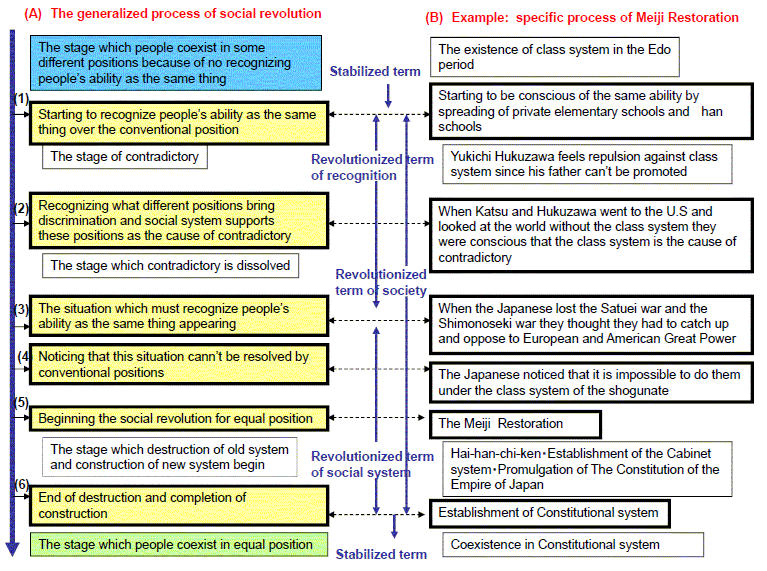 Paper: Social revolutions Paper: Social revolutions |

 
|
Generalized structure of social revolutions |
Tetsutarou YASUHIRA (Advaced Institute of Science and Technology, Japan)
Journal of Japan Society of Information and Knowledge, Vol. 20, No. 2., pp. 103-110 (2010)
|
Reposted in "TRIZ Home Page in Japan", Feb. 10, 2015
|
| Posted: Feb. 10, 2015 |
For going back to Japanese pages, press  buttons.
buttons.
 Editor's Note (Toru Nakagawa, Feb. 8, 2015)
Editor's Note (Toru Nakagawa, Feb. 8, 2015)
I met the Author, Mr. Tetsutarou Yasuhira, several times at Japan Creativity Society's symposia, and last December he sent me this (and 3 other) papers he published in J. Japan Society of Information & Knowledge. I was rather puzzled at first but when I read it I understood that he describes the processes of big social changes, or revolutions, in a general and conceptual way.
Since TRIZ tries to identify and solve contradictions to proceed for ideality, we know that we can apply TRIZ not only to technological problems but also non-technological, human, and social problems. Thus, I am happy to repost this paper here under the official permissions of JSIK. The abstract and the figure in English show the essence of the present paper, I hope. The full paper and author's profile are posted in the Japanese page.
Generalized structure of social revolutions
Tetsutarou YASUHIRA (Advanced Institute of Science and Technology, Japan)
Journal of Japan Society of Information and Knowledge, Vol. 20, No. 2., pp. 103-110 (2010)
Reposted in "TRIZ Home Page in Japan", Feb. 10, 2015
Abstract
We could make the following thing clear by applying the conditions causing and solving contradictory to some social revolutions:
- There are some positions a human can put himself in and normally he put himself in any position and coexist with other those who put themselves in the same and other positions.
- Presently they begin to feel the contradictory between the new recognition and the present situation by recognizing as the same thing what he didn’t recognize as the same thing.
- Further they can solve the contradictory by understanding that the cause of contradictory is the differences of old positions bringing discrimination or unfairness because of what new recognition cannot apply to and the social institution supporting them .
- Shortly the situation which needs the new recognition appears and when they understand that they can not resolve it because of their old positions, they begin to revolutionize their society irreversibly to the new position which their new recognition can apply to.
- But the difference of their distances between the new recognition and their old positions cause prompting power for revolution and resisting power against revolution and it can become the origin of the social confusion.
The significance which understand the revolution of our society in this way is to be able to know what stage our society is in when we encounter various revolutions and to prepare for.
Keywords: Social revolution, Period of revolution for recognition, Period of revolution for social institution, Discrimination, Unfairness

Fig.1 General structure of social revolution and its example of Meiji Restoration in Japan
 In Japanese page:
In Japanese page: 
Abstract  Full paper in HTML
Full paper in HTML  , in PDF
, in PDF 
Last updated on Feb. 10, 2015. Access point: Editor: nakagawa@ogu.ac.jp
